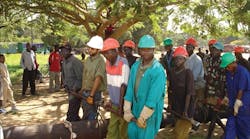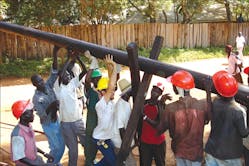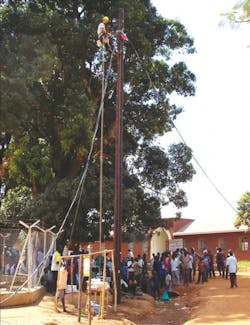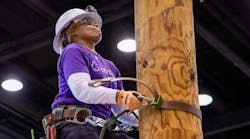For 20 years, southern Sudan, Africa, had been a war zone. The power infrastructure had been completely destroyed, and many residents had fled to neighboring countries. The villagers who remained in the region lived without electricity; when night fell, they illuminated their grass huts with candles. Because of the civil unrest, they did not feel safe walking outside after dark.
Then, eight years ago, everything changed. The United States Agency for International Development awarded the National Rural Electric Cooperative Association (NRECA) International US$4.8 million to re-electricify the small village of Yei following the end of the civil war. The NRECA sent a small team of American linemen to the town, which sits on the Little Nile River, to build a power grid from scratch. In one month, the volunteer linemen and local laborers set 87 poles, strung quadraplex and installed 26 streetlights in Freedom Square in Yei, a village in southern Sudan.
After a month of hard backbreaking labor, the linemen energized the streetlights. For the first time in many years, lights illuminated the streets at night. Cheering rippled through the village as kids played a night game of soccer and families danced in the streets. For the town located just 46 miles from the Ugandan border, the lights represented a glimmer of hope for a brighter future.
Volunteering Overseas
The linemen provided power to the village through NRECA International, which provides developing countries with access to safe, reliable and affordable electricity. By having lights and power, the communities can improve their quality of life, boost the productivity of their agricultural crops and create new jobs.
Back in 1999, the NRECA visited cooperatives in South Carolina and asked for volunteers to go overseas for a one-month international volunteer project.
Because the village was very remote, the volunteers had to fly from Uganda to Yei on a bush plane. After a few bumpy landings in the bush and four hours of flying, they landed on a dirt strip near the village. Culture shock immediately set in, and as the linemen stepped off the plane, they were greeted by nearly 700 soldiers. Because of internal warfare in Sudan, military presence continued for the next few days to protect the villagers and volunteers.
When the volunteers arrived in the village, they walked over to the grass hut in which they would be staying for the next month. After unpacking their belongings, they rounded up a small group of local volunteers to start the project of building the grid. Rather than just setting the poles, stringing the wire and then leaving the country, the linemen engaged the local community members in the construction and maintenance of the new power line.
Creating a Power Grid
Unlike in the United States, where linemen have access to battery-operated tools, bucket trucks and heavy equipment, the line work in southern Sudan was all done by hand. Without the technology, the linemen experienced what it was like for the U.S. field workforce back in the 1940s.
The volunteers brought a gas drill, climbing gear, boots and work clothes with them. When they left Sudan, they left all of this equipment with the local community workers. By bringing as much personal protective equipment and devices as they could, this would help to protect the local field workforce when maintaining their system.
The local laborers worked side by side with the American linemen, and through this experience, they learned how to safely and efficiently work on the power system. With no bucket trucks, it was essential for the volunteer linemen to teach the local crews how to climb the poles using fall protection. For this reason, the linemen spent a lot of their energy and effort on engaging the local workers in climbing exercises.
To create the grid, the linemen first dug the holes by hand. Then they had to tote the poles 1.5 miles away and install them with pike sticks. The poles were made from eucalyptus trees, which are crooked, but are planted in the United States because of their pleasant odor. For overseas line construction projects, these trees are a lot straighter and soaked in creosol to improve their longevity.
The linemen worked with the laborers to install poles ranging from 30 ft to 45 ft. To help get the job done within the one-month time frame, a contractor also brought in a local electrical crew to provide assistance at the end of the job.
Once all of the poles were set, they focused next on installing 26 streetlights in Freedom Square in the center of town. When the workers energized the circuit in October 2005, the villagers could read their books under the streetlights and stroll safely through the market area at night.
The workers’ overall goal was to equip each grass hut, school and building with a meter, light bulb, receptacle and switch. Empowering families to light up their homes at night and read to their children was a rewarding experience for the volunteer linemen.
The workers also changed the quality of life in the village by installing electricity for an electrical pump in the middle of town. In the past, the villagers had to walk for miles to reach a hand pump and get clean drinking water. With the reintroduction of electricity, they could get water for their families without ever leaving Yei.
The community medical clinic also greatly benefitted from the volunteer effort by the line crews. The small hospital had a generator, but it only worked some of the time. Now that the building had permanent power, the medical team could work to improve the health of the villagers around the clock.
Powering the African Village
By creating the new power grid, the town of Yei grew from just 10,000 people in 2005 to more than 17,500 today. Since 2005, the NRECA has built a larger power station in the town, extended the distribution system, created a locally owned utility to manage the power system and trained local managers in utility management.
Through the efforts of the volunteer linemen, they were able to give the villagers hope for what was to come. Yei, once known as Little London, was brought back to life with the reintroduction of electricity. In particular, the children within the village of Yei now have the opportunity for a better life. With lights now illuminating the local schools and electricity to power computers, they can continue to learn and grow at a faster rate than those generations before them. Power also is now available to hundreds of thousands of homes and businesses in the region through the new grid.
Other developing countries also are benefiting from the experience and expertise of the volunteer linemen. The NRECA sends line crews to work on projects in more than 42 countries worldwide. Today, the association is generating manpower and resources to send to the Philippines, which was ravaged by a typhoon.
Volunteering abroad often changes the linemen’s outlook on life, and it changes the way they see the world. By sharing their time and talents with others, they can help to light up the lives of others, one light bulb at a time.
Ashley Johnson ([email protected]) is the loss control and training director for The Electric Cooperatives of South Carolina in Columbia, South Carolina. In this role since, he is part of a team of five people responsible for the training of all the electric cooperative’s employees. He also helps to coordinate and takes part in teaching and training for the state. He entered the electrical industry in 1996 as a contractor, and Horry Electric Cooperative hired him in 1998. He traveled to the Dominican Republic and southern Sudan with the NRECA and support from Horry Electric Coop. He also has performed overseas missionary work in Haiti and Germany.
Companies mentioned:
The Electric Cooperatives of South Carolina | www.ecse.org
National Rural Electric Cooperative Association | www.nreca.coop
United States Agency for International Development | www.usaid.gov





